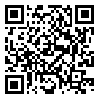Articles accepted at the time of publication
Back to the articles list |
Back to browse issues page
1- Chief of the Presidential Central Library , jamshidi2a@yahoo.com
2- Professor, Department of Linguistics and Foreign Languages, Faculty of Literature and Humanity Sciences, Payame Noor University (PNU),
3- Associate Professor, Department of Teaching Persian to Speakers of other Languages, Faculty of Literature and Humanity Sciences, Imam Khomeini International University, Qazvin, Iran.
4- Assistant Professor, Faculty of Basic Sciences, Department of Mathematics, Payame Noor University (PNU), Tehran, Iran.
2- Professor, Department of Linguistics and Foreign Languages, Faculty of Literature and Humanity Sciences, Payame Noor University (PNU),
3- Associate Professor, Department of Teaching Persian to Speakers of other Languages, Faculty of Literature and Humanity Sciences, Imam Khomeini International University, Qazvin, Iran.
4- Assistant Professor, Faculty of Basic Sciences, Department of Mathematics, Payame Noor University (PNU), Tehran, Iran.
Abstract: (417 Views)
This study employs graph theory to analyze the semantic network of Persian verbs among bilingual speakers. Situated within the frameworks of cognitive linguistics, lexical semantics (cognitive semantics), and computational linguistics, the research involves administering a questionnaire comprising 50 basic Persian verbs to participants, asking them to map the conceptual and intra-linguistic relationships between these verbs.The primary objective is to identify the most robust and frequent conceptual and intra-linguistic links among these verbs and to provide a detailed description of the graph structure constructed by bilingual speakers. The study seeks to address the question: What typology of conceptual and intra-linguistic relations is reflected in the graph patterns of non-Persian-speaking Iranians? The working hypothesis posits that semantic relations such as synonymy, antonymy, hyponymy, and collocation will manifest in this network.The methodology is field-based, and the instrument used is a localized questionnaire. Participants were instructed to diagrammatically represent any semantic relationships among the verbs provided.The findings demonstrate that the semantic graph constructed by Iranian bilinguals exhibits semantic relations such as synonymy (6.45%), reverse antonymy (34.94%), polysemy (7.79%), entailment (11.01%) (comprising "type-of" relations at 8.60% and "part-of" relations at 2.41%), as well as intra-linguistic collocation (28.22%). Among these, collocation, entailment, and antonymy were the most frequent relations, respectively.
Keywords: lexical (cognitive) semantics, semantic network, graph theory, bilingualism, Persian language education.
Article Type: مقالات علمی پژوهشی |
Subject:
Linguistics
Send email to the article author
| Rights and permissions | |
 |
This work is licensed under a Creative Commons Attribution-NonCommercial 4.0 International License. |






